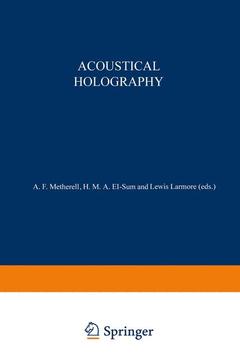Description
Acoustical Holography, 1969
Volume 1 Proceedings of the First International Symposium on Acoustical Holography, held at the Douglas Advanced Research Laboratories, Huntington Beach, California December 14-15, 1967
Coordinator: Metherell A.
Language: English
Keywords
diffraction; fast Fourier transform (FFT); holography; interference; laser; phase; research; sound; space; transparency; ultrasound; wave equation
Publication date: 02-2012
294 p. · 15.5x23.5 cm · Paperback
294 p. · 15.5x23.5 cm · Paperback
Description
/li>Contents
/li>
Only a space limitation of 115 seats prevented this First International Symposium on Acoustical Holography from having an attendance of over 250. Unfortunately, the size of the auditorium of the Douglas Advanced Research Laboratories required that attendance be by invitation only, and many deserving and interested scientists could not be present. This volume presents the proceedings of the symposium, and hopefully will help compen sate those individuals who were unable to attend. The symposium itself consisted of sixteen formal papers. The seven teenth, by Dr. P. Greguss, was not received in time to be read but is included in these proceedings. The presence of Professor Dennis Gabor considerably enhanced the informal sessions, which frequently became as spirited as one might expect in a new field. Dr. H. M. A. El-Sum, a consultant to the Douglas Advanced Research Laboratories and a pioneer in the field of holography, set the stage with the first paper. He provided a general introduction to the physical principles and practical methods involved in optical and acoustical holography. His paper also included a summary of various specific techniques currently used in sound holography, with the advantages, disadvantages, and limitations involved for each approach.
1 The Scope of the Symposium.- Definitions.- Generalized Principles of Holography.- Sound Recording.- Liquid Surface Deformation.- Scanning or Sampling Technique.- Mechanical Scanning.- Electronic Scanning.- Laser Beam Scanning.- Effect of Scanning on Hologram Reconstruction.- Direct Visualization of Sound Field by Bragg Diffraction of Light.- General Remarks.- References.- 2 A Survey of Ultrasonic Image Detection Methods.- Photographic and Chemical Methods.- Thermal Techniques.- Optical and Mechanical Methods.- Electronic Methods.- Conclusions.- References.- 3 The Liquid—Gas Interface as a Recording Medium for Acoustical Holography.- The Wave Equation.- The Boundary Conditions.- The Surface Deformation.- The Surface Under Plane Wave Excitation.- General Surface Excitations.- Conclusion.- References.- 4 A Comparison of Acoustical Holography Methods.- Acoustical Holography Employing a Liquid Surface.- Experimental Arrangement.- Analysis.- Two-step Holography Using a Liquid Surface.- Real-time Holography With a Liquid Surface.- Ultrasonic Holography Using a Scanned Hologram Method.- Construction of the Hologram.- Reconstruction of the Image.- Holograms and Reconstructions.- Conclusions.- Acknowledgments.- References.- 5 Acoustic Holographic Techniques for Nondestructive Testing.- Experiments.- The Acoustical Hologram.- Acoustical Hologram Recorder.- Visible Image Formation from the Acoustical Hologram.- Some Acoustical Holograms and Images.- Theoretical Analysis and Discussion of Some Properties of Acoustical Holograms.- General Theory.- Effects of Sampling the Acoustical Hologram.- Properties of the Image Formed by an Acoustical Hologram.- Potential Uses of Acoustical Holographic Techniques in Nondestructive Testing.- References.- 6 Application of Fourier Transforms in Assessing the Performance of an Ultrasonic Holography System.- A Criterion for the Maximum Frequency in a Hologram.- Analysis of the Effect of Scanning System on Recorded Information.- Analysis in the Fourier Transform Domain.- Practical Applications.- Summary.- References.- 7 Biomedical Prospects for Ultrasound Holography.- References.- Appendix. Ultrasound Holography and Visual Reconstruction.- Conclusions.- Acknowledgments.- References.- 8 Acoustical Holographic Model of Cetacean Echo-Location.- References.- 9 The Generation of Sound.- Sound Generation.- Sound Generation in a Gas.- Sound Generation in a Liquid.- Sound Generation in a Solid.- Detection of Sound.- References.- 10 Acoustical Imaging by Diffracted Light—Two-Dimensional Interaction.- Plane Wave Interaction Formalism.- Acoustical Imaging.- References.- 11 Acoustical Transparencies for Optical Imaging and Ultrasonic Diffraction.- Acoustical Transparencies.- Transparencies as Diffracting Screens.- Transparent Plates as Band-Pass Spatial Filters.- Transparent Plates for Velocity Measurement.- Conclusion.- References.- 12 Digital Image Formation from Detected Holographic Data.- Optical Image Reconstruction From Nonoptical Data.- Production of a Photographic Transparency.- Sources of Image Degradation.- Advantages of Optical Image Reconstruction.- Digital Image Reconstruction.- General Procedure.- The Required Digital Operations.- The Fast Fourier Transform.- Effects of Quantization, Sampling, and Scan Nonuniformities.- Quantization.- Sampling.- Scan Nonuniformities.- Experimental Results.- Summary and Conclusions.- References.- 13 Phase Distortions Due to Nonlinear Effects in an Acoustic Field.- Formulation of the Problem.- The Interaction Terms.- Description of Interference Pattern.- The Second-Order Induced Field.- Phase Distortion in Wavefront.- Conclusion.- References.- 14 The Relative Importance of Phase and Amplitude in Acoustical Holography.- Experiments.- General Instrumentation.- Reconstruction Technique.- First Experiments with the Letter “R”.- The Three Point-source Experiments.- Elimination of the Conjugate Images.- The Phase and Amplitude of an Object Wave.- Qualitative Mathematical Explanation.- A Point Object.- An Extended Object.- Qualitative Physical Explanation.- Conventional and “Phase-only” Hologram Fringe Patterns.- The Hologram as a Spatial Frequency Carrier.- Effect on Image Resolution.- Concluding Remarks.- Acknowledgments.- References.- 15 Acoustical Holograms and Optical Reconstruction.- Matrix Representation of Holographic Systems.- Scalar Sound Waves.- Matrix of a Lens.- Matrix of a Diffraction Grating.- Matrix of a Zone-Plate.- Matrix of Gabor’s Hologram.- Construction of Acoustical Holograms.- Experimental Arrangement.- Acoustical Hologram.- Optical Reconstruction of Images.- Reconstruction Condition.- Reconstruction of Virtual and Conjugate Images.- Experimental Results.- Effect of Scanning Lines on the Reconstructed Images.- Scanning Lines as a Diffraction Grating.- Effect of Scanning Lines on the Reconstructed Images.- Improvement of Reconstructed Images.- Effects of Hologram Construction Condition on the Reconstructed Images.- Effect of Light Intensity Level on the Reconstructed Images.- Effect of Limited Scanning Plane on Reconstructed Images.- Effect of Frequency of Sound Wave on Reconstructed Images.- Some Properties of Acoustical Holograms.- Detection of Objects in a Turbid and Turbulent Medium.- Three-Dimensional Information Storage in Acoustical Holograms.- Acknowledgment.- References.- 16 Ultrasonic Holography via the Ultrasonic Camera.- Acknowledgments.- References.- 17 Acoustical Filtering with Holographically Matched Spatial Filters.- Extending Spatial Filtering to Acoustic Waves.- Preliminary Experiments.- Results.- General Remarks.- References.- 18 Summary and Directions for Future Progress.- 19 Supplementary Bibliography.
© 2024 LAVOISIER S.A.S.




